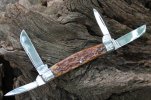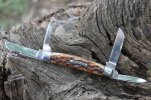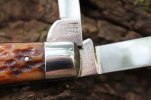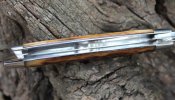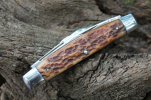That is a great story, Lee, and a fine old knife. I agree with your surmise about the function of the saber grind. Several of the large folding hunters that I posted (NYKCo Hammer Brand, Hibbard Spencer Bartlett, Ulster, Schatt & Morgan and Queen model 35) have saber grinds on their beefy blades. It provides, essentially, an internal (and additional) spine.Lots of great discussion and lovely knives above – this thread no doubt moves fast... Jeff – beauty of an old Robeson barlow!! Great showing of hunters Stuart and Charles, and Charles – great group of Hammer Brand knives, and that scitimar knife has me mesmerized ;-) … I had only seen a photo of one other and it was an Empire in tortoise shell… Mike – Another beauty of a Hammer Brand knife in jigged bone!! John – sweet old Germania knife!! With so many knives posted hope I didn’t forget any but pretty sure I hit "like" on all
…
With that cool run of beautiful hunters posted I wanted to share this oldie – one of my favorites from American Knife Co Thomaston (1849-1911 – Note that the company started as American Knife Co Plymouth (1849) and that stamp was used until the name of the town was changed to Thomaston in 1875 – accordingly this knife was made sometime between 1875-1911 – my guess is earlier than later in that time frame). Big folder at 5 & 3/8” closed with a nice ebony handle. The blade was no doubt used and abit dull on the edge but not sure ever sharpened – just used heavily - pretty full kick and choil still noticeable and blade is very full in length in liner well. I believe the blade would be termed a saber grind as the bevel starts at the middle of blade and not the spine which also sports a double swedge. From my understanding the saber blade design was made with the notion the blade would be stronger and more durable for tough uses – many tactical and military knives I believe have saber grinds as well. Nonetheless a unique blade for a folding hunter as many were clip blades (though I have a Holley Mfg Co Lakeville hunter that also is a big spear). The use of a nail nick rather than a long pull is rather interesting to me for such a long heavy blade. Just as an aside in terms of the knife’s story.. - I understand this knife was found in a barn where someone had forgotten it long ago and apparently left up on the rafters for most of the 1900s and into the 21st century when it was found – considering that and all steel construction there was surprisingly little active rust but no doubt some staining – but all in all excellent shape for its age etc… Hard snapping and tight with no wobble whatsoever… Thanks for looking!!




Cheers!
Lee
- Stuart





